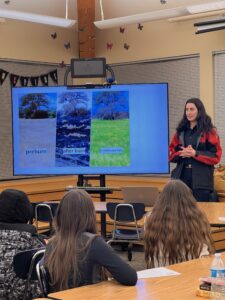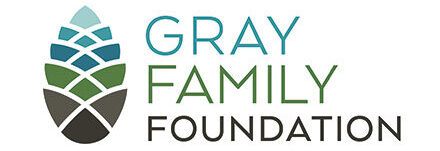 During a cultural enrichment night in early 2023, American Indian and Alaska Native (AIAN) students and their families gathered in a student kitchen at a Salem-Keizer School District (SKSD) high school to learn how to make sunflower cookies and berry compote from an Indigenous chef. As the cookies baked, a Nez Perce Tribal Member shared a story of how the Nez Perce navigated the land by reading the stars, and how they would catch salmon from the Columbia River and find huckleberries in the mountains. Then everyone who joined – multi generations of Indigenous students and families – ate the cookies together.
During a cultural enrichment night in early 2023, American Indian and Alaska Native (AIAN) students and their families gathered in a student kitchen at a Salem-Keizer School District (SKSD) high school to learn how to make sunflower cookies and berry compote from an Indigenous chef. As the cookies baked, a Nez Perce Tribal Member shared a story of how the Nez Perce navigated the land by reading the stars, and how they would catch salmon from the Columbia River and find huckleberries in the mountains. Then everyone who joined – multi generations of Indigenous students and families – ate the cookies together.
Cultural enrichment nights are one feature of the district’s Native Education Program (NEP), which provides programs, services, and academic coaching to the district’s AIAN students. The goal of the NEP is to increase knowledge of Tribal history and culture through Native-based curriculum, while promoting a sense of belonging at school among AIAN students. One way the NEP achieves this is through Oregon Geography education.
“Mainstream classroom geography lessons focus more on past and present changes on populations and land,” says Shelby Maerz, Native Education Program Associate and member of the Confederated Tribes of Grand Ronde. “The Native lens on geography includes oral traditions, stories of the people, learning old ways of living, how it affected the current lifestyles of our Indigenous peoples, and listening to Indigenous people’s perspectives on how things are changing, hearing their concerns, how our earth is taken care of, and how people are viewed and treated.”
Through the NEP’s summer programming, storytelling nights, and Oregon field trips, preK-12th grade AIAN students learn the geography of Oregon through a range of subjects, from arts, music, history, math, social studies, to physical education and wellness. By focusing on the five themes of geography – location, place, human environment interaction, movement, and region – students gain an understanding and connection to Tribal history and the various ways Native traditions influenced land use, land and water protection, resources, and how these have evolved. Lessons include hands-on physical activities for students to engage with the land, food, their families, and the Oregon Tribal members join as guest speakers.
Since Senate Bill 13 was signed in 2017, Oregon public schools are required to include AIAN curriculum for students of all backgrounds. The NEP program provides an additional space specifically for AIAN students to deepen their understanding and build on what they learn in school through a more hands-on approach. The focus on geography fosters connection to the ways land, people, and resources are traditionally valued, and how this impacts past and current culture and values, such as the treatment of tribe elders, and the ways the earth and water are protected.
“There’s just different perspectives on geography, and people are changing the geography and not taking care of the land, and it’s based upon what they see as values, “ says Maerz. “People aren’t going to be rich no matter how much money is in their pocket; they’re going to be rich if they take care of their land, have clean water, have food,have what they need like a sustenance culture like what our people were way back in the day.”
Looking ahead, Maerz says her hopes for the NEP program involve a community garden of first foods, Native Heritage Language, and more Oregon field trips.
